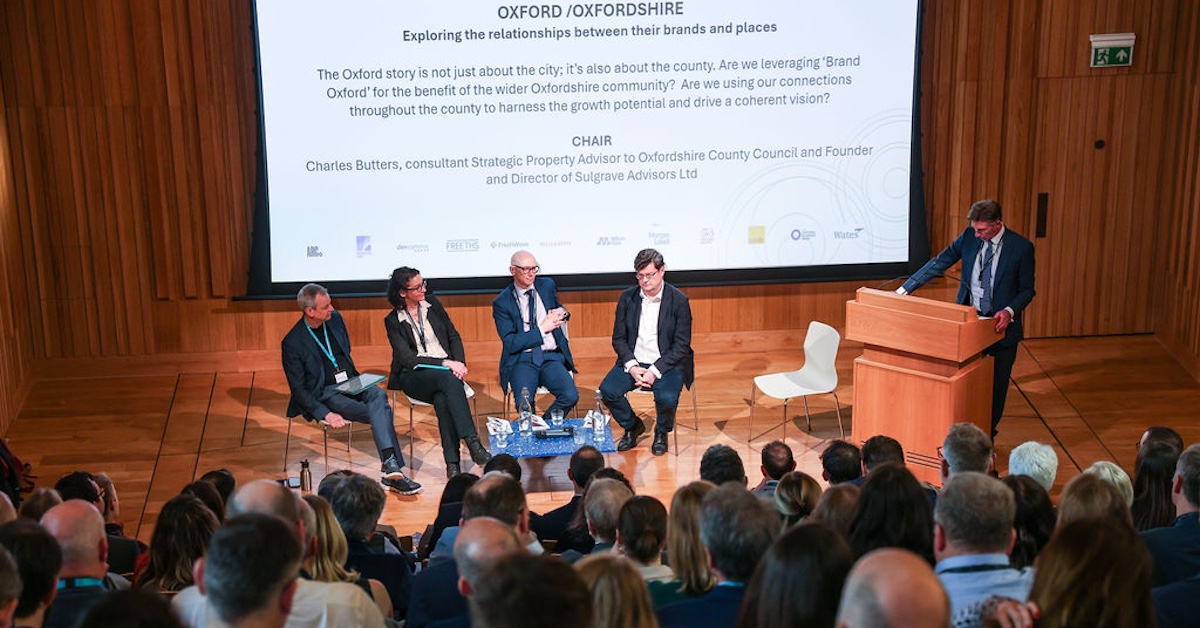A sold out crowd of around 250 property professionals crowd gathered at Trinity College, Oxford for the annual OxPropSummit event. Alan Bunce reports the highlights from the day’s six main sessions.
County council boss Martin Reeves says the power of the Oxfordshire brand and the charity sector’s input were the major positives he observed in his first two years.
Speaking in the opening debate (pictured above) of the day-long OxPropSummit at Trinity College, chaired by Sulgrave Advisors director Charles Butters, and which focussed on the branding of the city and county, the chief executive gave his impressions – positive and negative – since he came to Oxfordshire in 2023.
Martin, previously with Coventry City Council, said he did his due diligence on his new county but admitted two things still surprised him.
He said: “The first thing was the power of this place. As an economist, it’s even more powerful and potent than I had realised. The breadth and depth of the economic potential, across a number of sectors, was surprising to me.”
He named the voluntary and charitable sector, including grassroots originations, as the second area he had underestimated.
He went on: “I knew the charity sector, the not-for-profit, was really quite significant and special across Oxford and Oxfordshire but, having been in the job for two years, I’ve been pleasantly and positively surprised.”
He said he has learned that a much greater charity/not-for-profit ecosystem existed than he had thought, offering the city and the county financial and social gains.
Negatives he named were the disparity between haves and have nots in the county, which he said was more marked than he had thought and some of Oxford’s public realm, the area around Oxford Railway Station in particular.
He said: “As somebody who commutes in and out every single day, this global city does need to shine much brighter.”
He also highlighted how he feels some of the county’s market towns lacked vitality and vibrancy.
But he concluded: “So there are many good things but some challenges in front of us. But, by and large, wow, what a place.”
Caroline Green, chief executive of Oxford City Council, said in her 10 years in post she had seen the momentum of Oxford achieving its potential growing, with commercial and lab space in much greater demand after Covid.
But she added: “I think Oxford can be seen as a difficult place for development. The city council has tried, over a number of years, to really change that perception and be more open and accessible, right from the leadership to the planners and regen teams.”
Sebastian Johnson, director of ecosystems for Brookfield’s ARC brand, said the firm has invested around half a billion in the county, on top of investment by others.
He pointed to the Ellison Institute’s investment at The Oxford Science Park as a statement move.
He said: “We’ve got dynamic, brilliant, Larry Ellison coming to Oxford. Why did he come to Oxford? Because of the talent, the brand, the university and Harwell and Culham.”
Claus Andersen, head of life sciences at Freeths, who originates from Denmark but has been in the UK for 20 years, told the meeting the Golden Triangle is by far the biggest life sciences cluster in Europe but he warned Oxford must not be complacent.
He said: “You need to think of Oxford as a world city, a bigger place where you compete with the American clusters, the Chinese clusters and the emerging European clusters – and you need to maintain the momentum you’ve got.
“Do not just sit back and think it will materialise by itself.”
………………………………………………..
Delegates were given a strong hint that help is at hand to address infrastructure problems in Oxfordshire from the Ellison Institute of Technology (EIT) at a session on Going for Growth.
The session, chaired by Placi Espejo, director of the Oxford – Cambridge Pan Regional Partnership, heard from Matt Abney, senior director, real estate & special projects for EIT, who moved his family to the county from the US last year.
He is focussed on the EIT’s new 320,000 sq ft campus at The Oxford Science Park, currently under construction.
As debate turned to the obstacles to productivity and growth, he told guests: “For us as owner occupier and developer, if we are going to do what we want to do at the scale that we want to do it, which is further than what we’ve put through for planning right now, and we want to really grow and have a significant footprint, these infrastructure issues have to be unlocked.
“The takeaway for us has been, now that we are here and we’re in the mix and we see these challenges on a daily basis, that if there are ways that we are going to unlock infrastructure issues and housing issues – and these things are going to plague our growth – we have to step up to the plate. I think that’s a fair challenge.
“But it is challenging. It doesn’t just have to be money, there are other ways that we can contribute to tackling these problems. But I do think a lot of it falls on us in this community to try to come alongside our Government leaders to try to say ‘what is the part that we can do in this?’
“I know that’s difficult and bottom lines are challenging. I won’t talk to policies but I think there’s an imperative on those of us to step up where we can.”
………………………………………………..
The full business case for the re-opening of the Cowley branch line is due to be submitted within months, delegates heard in a panel debate on transport.
It is one of three rail projects moving forward in the Oxfordshire region.
During the discussion, chaired by Veronica Reynolds, sustainability and community manager for Milton Park, Tom Bridgman, executive director, development for Oxford City Council, said: “In late Spring we will be submitting the full business case. Our main target is the Spending Review in June so that’s the thing we are lobbying like mad to do.”
He said the line would serve around 6,000 homes which are already planned but could serve an further 5,000 – 10,000 which are yet to be planned.
In addition, he said the council estimates 2.5 million sq ft of commercial space could be created if the branch line is delivered.
Martin Philips, strategy director for East West Rail, told the meeting of similar optimism for that project.
He said: “I’ve been working on East West Rail for six years and it really feels like it’s going to happen now. Depending on the planning process, we should be running services between Oxford and Cambridge by the mid 2030s.”
And Charlie Maynard, LibDem MP for Witney, who has long campaigned for a new link between Oxford, Carterton, Witney and Eynsham said the Government shared his optimism that that line will now happen.
He said: “What’s changed over the last few years is that, at the start of this we had a district council that opposed it, now the district council is strongly in favour.
“We had a county council that opposed it, now it’s strongly in favour. And now the MP, is apparently rather supportive.”
He said the Labour Government is putting money into Oxfordshire and wanting it to succeed.
………………………………………………..
Landowners are facing unprecedented times, delegates heard at a session on the issues around estate ownership.
Chairing the debate, Laura Ludlow, associate at law firm Mills & Reeve, which advises more than 250 estate owners of all types and sizes, spoke of the difficulties in generating income from traditional agriculture.
She said: “It’s becoming much tougher to make money from farming – the basic commodity such as arable and dairy farming.
“So our rural estates really need to adapt and evolve in order to survive. For our farming clients, their basic payments scheme has gone and the sustainable farming incentive scheme was pulled at really short notice, which caught out a lot of estates.
“Any estates that are relying on agricultural rents are seeing a lot of pressure put on these rents and we see pressure from supermarkets and consumers over the price of food.
“And we all know the recent controversy about the tax changes that have been proposed, making it more expensive for the next generation at these estates to carry on.”
She said many are now looking at fundamental restructuring of their estates. Mills & Reeve has witnessed an increased focus on environmental schemes including energy generation which can potentially offer good returns.
Creating widely-varied visitor attractions such as adventure play parks, farm shops and cafes also generates income. Laura added (with a smile): “And can you even call yourself a model estate if you haven’t hosted a music festival?”
Mike Doran, leasing & asset manager for Bicester Motion, pointed to the 50 businesses it hosts at the 444-acre former airfield and the new vertiport.
Roy Cox, managing director (rural & estates) for 12,000-acre Blenheim Estate, a World Heritage Site which welcomes a million visitors a year, pointed to the need for visitor income and highlighted the expense involved in running a site such as Blenheim.
He said: “It costs around £4 million a year for upkeep of the World Heritage Site before we even turn a light on, so leisure is a vital part of that.”
He noted that if a visitor stays overnight in the area, it multiplies their economic impact by around 17 times.
Freddie James, director for estate asset manager Belport, described how farm shops and other attractions, which bring income to rural estates, also add community value.
He added: “In rural communities, village shops and Post Offices have shut so a sense of place can come through creating these kinds of assets.”
………………………………………………..
Imaginative ways to involve communities in schemes were laid out in a debate on responsible development.
Victoria Collett, development director for Thomas White Oxford (TWO), which is behind the Oxford North scheme, said TWO is now fully embedded in the community, despite not being popular at first.
In the debate, chaired by Savills director Emily Slupek, Victoria explained how TWO asked local community groups if they wanted a new hall.
She went on: “They said ‘no’. We were surprised. They said ‘we’ve already got lots of community spaces in Wolvercote and we really struggle to maintain them and to look after them and to run them’.”
Instead, TWO offered the help of contractors from its site, who could provide maintenance of the groups’ premises and even a skip for clearing space.
Greg Hill, chief executive of Hill Group, said it is necessary, both to get out and meet people and engage, and to live up to promises.
He said: “Generally what we find is, when we get to the end of a project, the type of people who have been objecting to our projects actually end up living in them.”
He pointed to one development where a buyer reserved a property before it was built but cancelled when he learned of another development nearby because he didn’t want new homes near his.
Greg added: “It’s a challenge that isn’t going to go away.”
Andy Edwards, executive director of Makespace Oxford, a not-for-profit which helps create ‘meanwhile’ space for community organisations, suggested what he called ‘flipping the dynamic entirely’ where, rather than developers consulting communities on schemes, communities are asked what they would like to see, making them effectively co-designers.
“That is an opportunity for nimbies to become yimbies,” he said.
Trevor Payne, director of estates for the University of Oxford, argued that development must benefit communities.
But he added: “I think where we get it wrong is we don’t always tell the story in a really clear way so people see all the negative aspects – the lorries, the disruption, the noise – and I think we need to spend time getting out there and seeing the right people and tell the story in a really clear way.”
………………………………………………..
A debate on planning, chaired by DevComms managing director Rob Allaway, explored, not just the system, but how its problems were compounded by those of infrastructure and forthcoming devolution.
Rob told the meeting the amount of simultaneous changes going on in the planning system was the most he had ever seen in his career.
Rachel Wood, managing director of Sladen Estates, who joined us in the Battle & Bunce Talking Property podcast alongside Charles Butters recently, gave Bicester Arc as an example of infrastructure issues her firm faces.
The developer had been quoted a price of £750,000 by SSE for electricity to the business park, only to learn later that sufficient power was not available.
Sladen Estates then had to build its own substation at a cost of £14m. And that was after robust lobbying of politicians.
She said: “When we are talking about economic growth, not all developers are able to absorb that sort of cost.”
Sladen Estates has also found Thames Water not always willing to engage – and on one occasion demanded £11,000 to meet.
In another scheme outside the region, she said Sladen Estates had occupiers desperate to take space at an industrial scheme but were delayed by a highways authority.
She said: “As we’re working through the planning system, which has its own issues, we’ve got to know that when we get a permission, we can actually start onsite. And in a lot of instances, we don’t necessarily know that we can.”
David Butler, head of planning for Oxford City Council, pointed to the fact that, while agreement has been reached over the city’s sewage works upgrade, capacity will again be reached by 2031.
He added: “If we’re not planning now for 2031, when we get to 2031, we’re going to have the same problem.”
The planning system’s problems were summed up by Rachel Wood – a lack of resource at local authorities.
She said: “I’ve dealt with good planning officers who get promoted, so they are taken away from the coalface and you are left with planning officers who might come in as consultants, who live remotely.
“I had one who lived in Yorkshire and had no intention of coming to the site.”
Ian Green, chairman of Oxford Civic Society, pointed to another problem facing local authorities.
He said: “The local planning authorities, the district councils responsible for planning, are being asked by Central Government to push to deliver 1.5 million homes and there are at least 150 decisions to be made on major projects within this Parliament.
“At the same time, those district councils, which are not yet unitarised, are also being told ‘oh by the way you’re being abolished’.
“It’s not the best way to incentivise the local planning authorities.”
He said efforts to speed up planning by allowing more delegated decisions risk taking development decisions away from the public, which would exacerbate an existing problem.
He went on: “In a lot of the things we’re doing in Oxfordshire, we’re not taking the local population with us.
“We’re not taking the population of the county, the city or the districts with us on many other things we’re doing and I think we risk diluting the planning committees by taking political element out of it.”
The panel lamented the loss of the Oxfordshire 2050 Plan which was abandoned when the various councils could not agree.
But Hannah Battye, head of place shaping, economy & place for Oxfordshire County Council, said some of the work done on it could be used by the incoming authority.
She said: “We are dusting it off and seeing what we can resurrect.”
See the gallery of the day here.
© Thames Tap (powered by ukpropertyforums.com).
Sign up to receive our weekly free journal, The Forum here.











